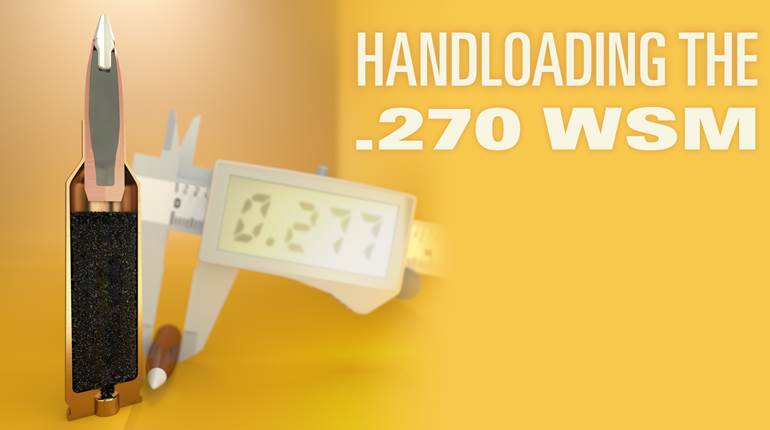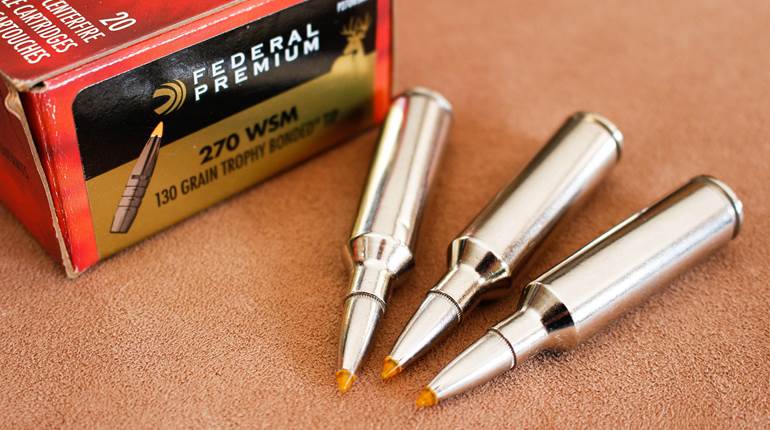
In 1912, Holland & Holland introduced the term “magnum” to describe what was then an oversized cartridge case designed to provide greater velocity and terminal energy over the then-standard cartridges of the day. The .375 H&H Mag. was head and shoulders above the so-called medium bores of the day. Its 2.85" length and 0.513" base diameter created a capacity of 95 grains of water. The cartridge was a winner then and remains a standard today.
However, like most inventions, people try to improve on the original. It didn’t take long for Holland & Holland to neck down the .375 H&H Mag. to .30 caliber—about 13 years—and produce the .300 H&H Mag. The .300 H&H Mag. was a marked improvement at the time over the standard .30-’06 Sprg.—some 300 f.p.s. faster with the 180-grain bullet—but it required a rather long, heavy and often expensive action to house it.
Fast forward to 1956 when Winchester took that 2.85" case and shortened it to 2.500", blew it out to .45 caliber, and thus created the first “short magnum” cartridge, the .458 Win. Mag. Seven years after that, Winchester debuted the .300 Win. Mag.—necking down the .458 Win. Mag. to .30 caliber and giving it a rather short 25-degree shoulder angle. The .300 Win. Mag. was an immediate success and has become one of the best open-country big game cartridges for so-called thin-skinned game.
Nonetheless, the tinkerers continued to tinker. They wanted a shorter bolt throw, a lighter action—and rifle—and that belt at the rear of the case had to go. Most handloaders resized their cases to headspace on the shoulder, like most cartridges do. The belt was deemed superfluous, so in the late 1990s, Winchester engineers started looking for a fatter case without a belt to base a new “short magnum” cartridge. They took the old .404 Jeffery case, shortened it to 2.1"—a smidgen more than the .308 Win.—put a 35-degree shoulder on it and christened it the .300 Winchester Short Magnum (WSM). Debuting at the 2001 SHOT Show, it generated a fair amount of interest. Winchester immediately began developing other WSM cartridges, beginning with the .270-cal. and 7 mm WSM cartridges.
 A comparison, from left to right, of the .270 Win., .270 WSM, .300 Win. Mag. and .30-'06 Sprg.
A comparison, from left to right, of the .270 Win., .270 WSM, .300 Win. Mag. and .30-'06 Sprg.
On Sept. 11, 2001, I was privileged to be on the first hunt with the .270 WSM near Monticello, Utah. As the twin towers fell, we were unaware of the havoc being ravaged on our country some 2,000-plus miles from us. When we found out about the attack, air travel had been shut down across the country. Phone lines back to the east were hopelessly overloaded. There wasn’t much for us to do but to continue our hunt. I knocked down a nice mule deer buck a day later from a distance of 265 yards by rangefinder.
The .270 WSM and 7 mm WSM were introduced to the public at the 2002 SHOT Show. Still later, a .325 WSM was spawned. Wildcatters went nuts necking the “new” WSM cases up and down through the dimensional spectrum—everything from .22- to .375-cal.—but the .270 WSM seems to have shaken down to be the best of the WSMs, judging by its acceptance. In my opinion, here’s why:
When Winchester necked down the .30-'06 Sprg. to accept .277-cal. bullets in 1925, it initiated a bullet speed race that continues to this day. The .30-'06 Sprg. had the tremendous advantage of being the standard U.S. military rifle cartridge of the time, and surplus ammo along with needed components were both cheap and plentiful. As such, the .270 Win. gained a fairly quick and widespread acceptance with hunters throughout North America. It is a fast, relatively light-recoiling and accurate round that—once good bullets were designed to operate at its velocity (3,100 f.p.s. for the 130-grain bullet)—could be counted on to reliably take big game up to and including elk. That, and the fact that it was regularly touted by Jack O’Connor, one of the most admired outdoor and hunting journalists of the day for more than 40 years, ensured its embrace into the bosom of American riflemen and hunters.
The .270 WSM was not the first improvement of that caliber. Roy Weatherby introduced his .270 Weatherby in 1943, but it never caught on as much, mostly because Weatherby’s cartridges are proprietar, and therefore had less distribution than could be had with heavy hitters like Winchester and Remington. That’s not to ding the Weatherby cartridges; they are accurate, fast and very effective on game, but the proprietary nature simply meant that only the well-heeled or avid aficionado would use them. The .270 WSM comes very close to the .270 Weatherby in performance, and does so in a smaller and more lightweight package. Weatherbys need a 26" barrel and longer, heavier actions to achieve their speed. The .270 WSM is in a shorter action with a 24" barrel, and is less costly.

In terms of performance, the .270 WSM is one of the relatively rare instances where the published data is pretty close to real-world numbers. Most claim about 3,290 f.p.s. with a 130-grain bullet and 3,250 f.p.s. with a 140-grain bullet. My Winchester Model 70 Featherweight in .270 WSM clocks in 3,260 f.p.s. with a Berger 130-grain hollow point bullet, and 3,225 f.p.s. with 140-grain Barnes TSX bullets. As an experiment, when Barnes came out with the 110-grain TSX, I was able to get 3,488 f.p.s. before chickening out. That load, by the way, shot like a laser to 400 yards before dropping quickly, and was like a death ray on pronghorn.
My experiences with both the .270 Win. and its newer brother are not exhaustive. Nevertheless, they do seem to be indicative of the experiences other hunters have had with these cartridges. I’ve taken probably eight pronghorn, close to a dozen mule deer and whitetails along with a couple of elk, including the one pictured in this article. That bull was killed in the Scapegoat Wilderness of Montana with a 140-grain TSX at 80 yards, and dropped in its tracks after a three-hour marathon calling contest. The most common claim regarding the .270 WSM is, “It’s like the .270 Win., only better.” That rifle has become my go-to for pronghorn and open-country deer.
No, the .270 WSM isn’t in any top-10 cartridge popularity lists that I am aware of. The .300 WSM edges it out a bit, and cartridges like the .270 Win., .30-'06 Sprg., .300 Win. Mag. and even the 7mm Rem. Mag. outsell it. Of course, those cartridges have a 60- to 90-year head start. But I still like it.





































